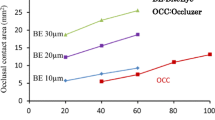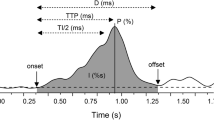Abstract
Goal This study tests the hypothesis of loading-dependence on the temporomandibular joint during clenching on the particular of experimentally partial edentate conditions. Methodology A complete and detailed finite element model of the temporomandibular joint (TMJ) was used. The closing movement of the mouth was reproduced by contracting the closing muscles of the masticatory system. Electromyography (EMG) data were taken from 10 healthy, dentulate volunteers, both with and without intraoral appliances. The intraoral appliances served to mimic nine partially edentulate (PE) conditions for each volunteer. The EMG data were fed into the finite element model (FEM) for each condition and the loading of the joint was analyzed. Results The results obtained show that muscular activity decreases when the contact between teeth disappears. In particular, the numerical results showed that when there is no contact between the posterior teeth an overload of the joints appeared. Moreover, the existence of a unilateral unique molar induced asymmetric overloading in the TMJ disc without posterior contact. Conclusions During clenching, a uniform distribution of the dental contact along the maxillar arches prevents the TMJ from overloading. In contrast, severe partial edentation seems to induce overloading of the TMJ with severity depending on the type of contact.





Similar content being viewed by others
References
Al-Jabrah O., Al-Shumailan Y. R. 2006. Prevalence of themporomandibular disorder signs in patines with complete versus partial dentures. Clinical Oral Investigations 10(3):167–173
Beek M., Koolstra J. H., van Ruijven L. J., van Eijden T. M. 2000. Three-dimensional finite element análisis of the human temporomandibular joint disc. J Biomech 33(3):307–16
Berkovitz B. K. B. 2000. Collagen crimping in the intra-articular disc and articular surfaces of the human temporomandibular joint. Arch Oral Biol 45:749–756
Carlsson G. E. 1999. Epidemiology and treatment need for temporomandibular disorders. J Orofac Pain 13(4):232–7
Carvalho R. S., Yen E. H., Suga D. M. 1995. Glycosaminoglycan synthesis in the rat articular disk in response to mechanical stress. Am J Orthod Dentofacial Orthop 107(4):401–10
Chen C.-Y., Palla S., Erni S., Sieber M., Gallo L. M. 2007 Nonfunctinal toot contact in healthy controls and patients with myogenous facial pain. J Orofac Pain 21:185–193
Chung J. W., Kim C., McCall Jr W. D. 2002. Effect of sustained contraction on motor unit action potentials and EMG power spectrum of human masticatory muscles. J Dent Res 81(9):646–649
Detamore M. S., Athanasiou K. A. 2003 Tensile properties of the porcine temporomandibular joint disc. J Biomech Eng 125(4): 558–65
Ferrario V. F., Tartaglia G. M., Galletta A., Grassi G. P., Sforza C. 2006. The influence of occlusion on jaw and neck muscle activity: a surface EMG study in healthy young adults. J Oral Rehabil 33(5):341–348
Fogle L. L., Glaros A. G. 1995. Contributions of facial morphology, age, and gender to EMG activity under biting and resting conditions: a canonical correlation analysis. J Dent Res 74:1496–1500
Gal J. A., Gallo L. M., Palla S., Murray G., Klineberg I. 2004. Analysis of human mandibular mechanics based on screw theory, in vivo data. J Biomech 37:1405–1412
Gallo L. L., Gross S. S., Palla S. 1999. Nocturnal masseter EMG activity of healthy subjects in a natural environment. J Dent Res 78(8):1436–1444
Greene, C. S. Concepts of TMD etiology: effects on diagnosis and treatment. In: TMDs An Evidence-Based Approach to Diagnosis and Treatment, edited by D. M. Laskin, C. S. Greene, and W. L. Hylander. Quintessence Publishing Co, Inc., 2006.
Hattori Y., Satoh C., Seki S., Watanabe Y., Ogino Y., Watanabe W. 2003. Occlusal and TMJ loads in subjects with experimentally shortened arches. J Dent Res 82(7):532–536
Helkimo N., Ingervall B., Carlsson G. E. 1975. Comparison of different methods in active and passive recording of the retruded position of the mandible, Scand J Dent Res 81:265–271
Hirose M., Tanaka E., Tanaka M., Fujita R., Kuroda Y., Yamano E., van Eijden T. M., Tanne K. 2006. Three-dimensional finite-element model of the human temporomandibular joint disc during prolonged clenching. Eur J Oral Sci 114(5):441–8
Holzapfel G. A. 1998. Nonlinear Solid Mechanics. Wiley, New York
Iwasaki L. R., Nickel J. C., McLachlan K. R. 1997. Relationship between growth, function, and stress in the temporomandibular joint. In: McNeill C (eds) Science and practice of occlusion. Quintessence, Chicago, pp. 125–136
Johansson A., Unell L., Carlsson G. E., Söderfelt B., Halling A. 2003. Gender difference in symptoms related to temporomandibular disorders in a population of 50-year-old subjects. J Orofac Pain 17(1):29–35
Koolstra J., Van Eijden T. M. G. J. 2005. Combined finite element and rigid body analysis of human jaw joint dynamics. J Biomech 38(2): 2431–9
Langenbach G. E. J., Hannam A. G. 1999. The role of passive muscle tensions in a three-dimensional dynamic model of the human joint. Arch Oral Biol 44:557–573
Marcus, S. E., T. F. Drury, L. J. Brown, and G. R. Zion. Tooth retention and tooth loss in the permanent dentition of adults: United Status, 1988–1991. J. Dent. Res. Feb; 75 Spec No:684–695, 1996.
May B. M., Garabadian C. 2000. Reducing condylar compression in clenching patients. Crit. Rev. Biomed. Eng, 28(3–4):389–94
McGivnet G. P., Castleberry D. J. 1995. McCracken’s Removable Partial Prosthodontics, 9th edition. Mosby-Year Book, Inc.St.Louis, MI. pp 17–23
McNeill C., Mohl N. D., RTanatan T. T. 1990. Temporomandibular disorders: diagnosis, management, education and research. J Am Dent Assoc 120:252–263
Møller E, Bakke M. 1988. Occlusal harmony and disharmony: frauds in clinical dentistry? Int Dent J. 38(1):7–18
Nagahara K, Murata S, Nakamura S, Tsuchiya T. 1999. Displacement and stress distribution in the temporomandibular joint during clenching. Angle Orthod 69(4):372–9
Nickel J. C., McLachlan K. R. 1994. In vitro measurement of the stressdistribution properties of the pig temporomandibular joint disc. Arch Oral Biol 39:439–448
Nitzan D. W. 2001. The process of lubrication impairment and its involvement in temporomandibular joint disc displacement: a theoretical concept. J Oral Maxillofac Surg 59:36–45
Peck C., Langenbach G., Hannam A. 2000. Dynamic simulation of muscle and articular properties during human wide jaw opening. Arch Oral Biol 45:963–982
Peck C., Murray G., Johnson C., Klineberg I. 1999. Trajectories of condylar points during nonworking side and protrusive movements of the mandible. J Prosthet Dent 82:322–331
Pérez del Palomar A., Doblaré M. 2006. The effect of collagen reinforcement in the behaviour of the temporomandibular joint. J Biomech 39(6): 1075–1085
Pérez del Palomar A., Doblaré M. 2006. Finite element analysis of the temporomandibular joint during lateral excursions of the mandible. J Biomech 39(12): 2153–2163
Pérez del Palomar A., Doblaré M. 2006. 3D finite element simulation of the opening movement of the mandible in healthy and pathologic situations. J Biomech Eng. ASME; 128(2): 242–249
Pérez del Palomar A., Doblaré M. 2006. On the numerical simulation of the behaviour of articular cartilage. Int J Num Meth Eng 67(9): 1244–271
Pirttiniemi P. 1998. Normal and increased functional asymmetries in the craniofacial area. Acta Odontol Scand 56(6):342–345
Racich M. J. 2005. Orofacial pain and occlusion: Is there a link? An overview of current concepts and the clinical implications. J Prosthet Dent 93:189–96
Sarlani E., Greenspan J. D. 2005. Why look in the brain for answers to temporomandibular pain? Cells, Tissues, Organs, 180:69–75
Sato F., Kino K, Sugisaki M., et al. 2006. Teeth contacting habit as a contributing factor to chronic pain in patients with temporomandibular disorders. J Med Dent Sci, 53:103–109
Scapino R. P., Obrez A., Gresing D. 2006. Organization and function of the collagen fiber system in the human temporomandibular joint disk and its attachments. Cells Tissues Organs 182(34): 202–225
Shengyi T., Yinghua X. 1991. Biomechanical Properties and Collagen Fiber Orientation of TMJ Discs in Dogs: Part I. Gross Anatomy and collagen fiber orientation of the Discs. J Craniomand Disord, 5:28–34
Svensson P., Wang K., Sessle B. J., Arendt-Nielsen L. 2004. Associations between pain and neuromuscular activity in the human jaw and neck muscles. Pain 109:225–232
Tallents Tallents R. H., Macher D. J., Kyrkanides S., Katzberg R. W., Moss M. E. 2002. Prevalence of missing posterior teeth and intraarticular temporomandibular disorders. J Prosthet Dent 87(1):45–50
Tanne K., Tanaka E., Sakuda M. 1995. Stress distribution in the TMJ during clenching in patients with vertical discrepancies of the craniofacial complex. J Orof Pain 9(2): 153–160
The Academy of Prosthodontics. 2005. The Glossary of Prosthodontic Terms. J Prosthet Dent 94(1):10–92
van Eijden T. M. G. J., Korfage J. A. M., Brugman P. 1997. Architecture of the Human Jaw-closing and Jaw-opening muscles. Anat Rec, 248:464–474
van Ruijven L. J., Weijs W. A. 1990. A new model for calculating muscle forces from electromyograms. Eur J Appl Physiol, 61:479–485
Wong M., Carter D. R. 2003. Articular cartilage functional histomorphology and mechanobiology: a research perspective. Bone 33:1–13
Acknowledgments
The authors thanks to Prof. Otero Cepeda from the Statistics Department of Santiago de Compostela University for his support in the statistical part. The authors gratefully acknowledge the support of the Spanish Ministry of Education and Research through the research project DPI2006-14669.
Author information
Authors and Affiliations
Corresponding author
Rights and permissions
About this article
Cite this article
Pérez del Palomar, A., Santana-Penín, U., Mora-Bermúdez, M.J. et al. Clenching TMJs-Loads Increases in Partial Edentates: A 3D Finite Element Study. Ann Biomed Eng 36, 1014–1023 (2008). https://doi.org/10.1007/s10439-008-9487-y
Received:
Accepted:
Published:
Issue Date:
DOI: https://doi.org/10.1007/s10439-008-9487-y




